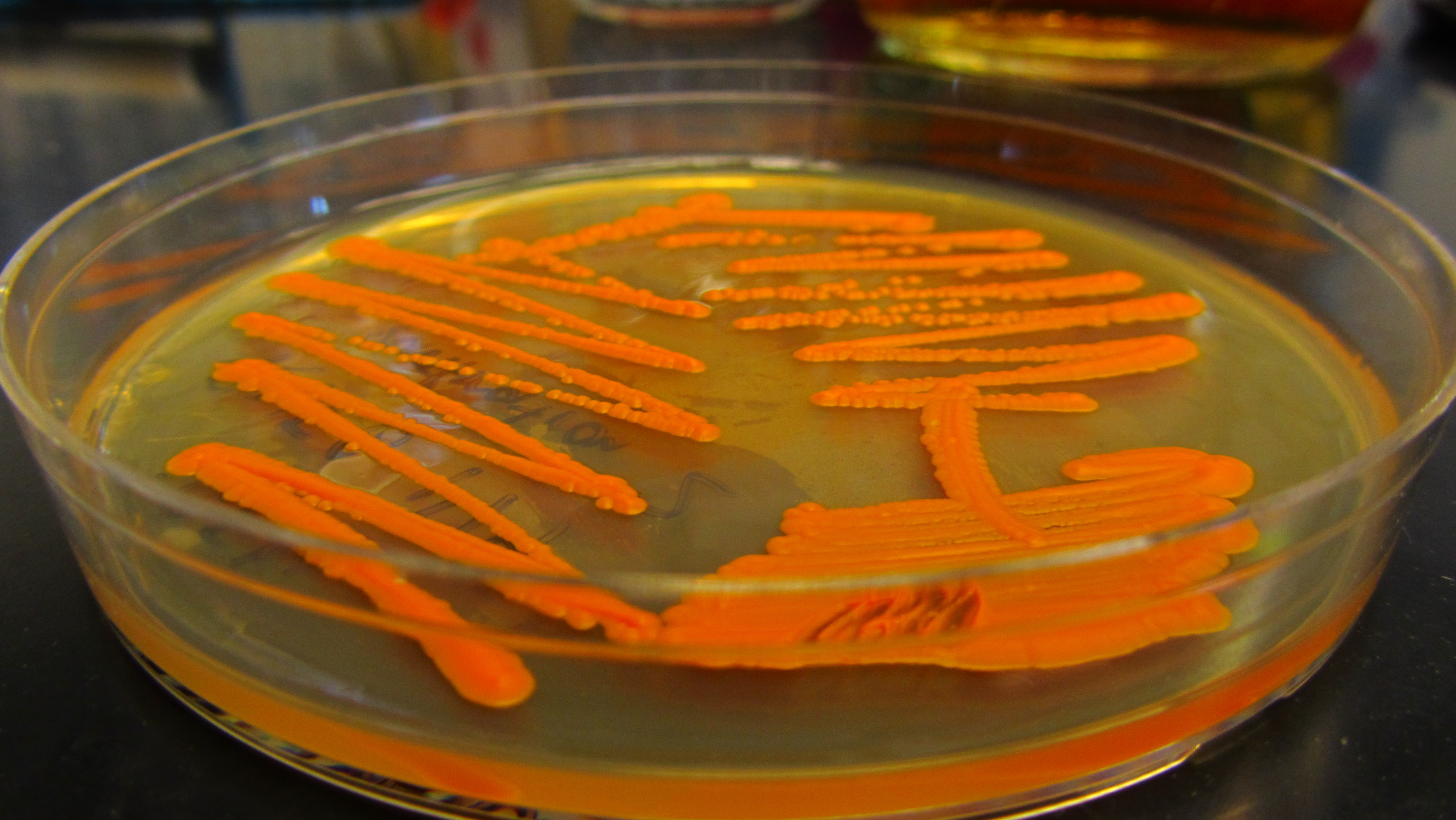|
|
| Line 23: |
Line 23: |
| | ======Overview====== | | ======Overview====== |
| | [[File:IMG 2345.JPG|thumb|300px|A plate with Vitamin A yeast streaked out]] | | [[File:IMG 2345.JPG|thumb|300px|A plate with Vitamin A yeast streaked out]] |
| - | We demonstrated and characterized the production of pro Vitamin A, ''beta''-Carotene, in ''Saccharomyces cerevisiae'', by importing three carotegenic genes from ''Xanthophyllomyces dendrorhous'', namely carotene desaturase, GGPP synthase, phytoene synthase. The quantification was done via HPLC analysis and spectrophotometric assays over time. We also ran a comparative study of our yeast strains efficiency in dough versus in lab conditions using a novel substrate, dough media plates. We see production of significant amounts of ''beta''-carotene from this strain. | + | We demonstrated and characterized the production of pro Vitamin A, ''beta''-Carotene, in ''Saccharomyces cerevisiae'', by importing three carotegenic genes from ''Xanthophyllomyces dendrorhous'', namely carotene desaturase, GGPP synthase, phytoene synthase. The quantification was done via HPLC analysis and spectrophotometric assays over time. We also ran a comparative study of our yeast strains efficiency in dough versus in lab conditions using a novel substrate, dough media plates. We saw production of significant amounts of ''beta''-carotene from this strain. |
| | | | |
| | We have engineered a strain of ''Saccharomyces cerevisiae'' to express L-ascorbic acid, or Vitamin C, for use in the baking of bread and brewing of beer. We codon-optimized three genes from the Vitamin C pathway of ''Arabidopsis thaliana'' and made them BioBrick compatible. These were then constructed de novo and assembled into expression cassettes. We are currently in the process of characterizing the Vitamin C production via HPLC and photospectrometric assays. We are also in the process of constructing a combinatorial library of expression cassettes with 11 different strength promoters and terminators and have designed a selection and screening protocol to optimize production. | | We have engineered a strain of ''Saccharomyces cerevisiae'' to express L-ascorbic acid, or Vitamin C, for use in the baking of bread and brewing of beer. We codon-optimized three genes from the Vitamin C pathway of ''Arabidopsis thaliana'' and made them BioBrick compatible. These were then constructed de novo and assembled into expression cassettes. We are currently in the process of characterizing the Vitamin C production via HPLC and photospectrometric assays. We are also in the process of constructing a combinatorial library of expression cassettes with 11 different strength promoters and terminators and have designed a selection and screening protocol to optimize production. |
Overview

A plate with Vitamin A yeast streaked out
We demonstrated and characterized the production of pro Vitamin A, beta-Carotene, in Saccharomyces cerevisiae, by importing three carotegenic genes from Xanthophyllomyces dendrorhous, namely carotene desaturase, GGPP synthase, phytoene synthase. The quantification was done via HPLC analysis and spectrophotometric assays over time. We also ran a comparative study of our yeast strains efficiency in dough versus in lab conditions using a novel substrate, dough media plates. We saw production of significant amounts of beta-carotene from this strain.
We have engineered a strain of Saccharomyces cerevisiae to express L-ascorbic acid, or Vitamin C, for use in the baking of bread and brewing of beer. We codon-optimized three genes from the Vitamin C pathway of Arabidopsis thaliana and made them BioBrick compatible. These were then constructed de novo and assembled into expression cassettes. We are currently in the process of characterizing the Vitamin C production via HPLC and photospectrometric assays. We are also in the process of constructing a combinatorial library of expression cassettes with 11 different strength promoters and terminators and have designed a selection and screening protocol to optimize production.
In order to assess the efficiency and effectiveness of our yeast strains, we performed a series of quantitative measurements which would allow us to determine protein expression levels, amount of products and bi-products synthesized, and kinetic rates of the enzymes in our system. The results of these experiments also provide important initial conditions for the modeling aspect of our project, as it provides us with reliable and realistic in vivo gene expression and catalytic activity of the enzymes specific to our system. By using a combination of High Performance Liquid Chromatography, Column Chromatography, Fluorescence Microscopy, and Spectroscopy these quantitative measurements were performed.
We have also used a bread machine to bake bread with the yeast strain that contains Vitamin A. Using the aforementioned methods, we aim to quantify the amount of Vitamin A that is in the bread and see how well this application of lab yeast to the real world constructs performs.
Relevant Parts
| Vitamin A
| Vitamin C
|
| [http://partsregistry.org/wiki/index.php?title=Part:BBa_K530001 crtE]
| [http://partsregistry.org/wiki/index.php?title=Part:BBa_K530025 GLGP]
|
| [http://partsregistry.org/wiki/index.php?title=Part:BBa_K530000 crtYB]
| [http://partsregistry.org/wiki/index.php?title=Part:BBa_K530026 GME]
|
| [http://partsregistry.org/wiki/index.php?title=Part:BBa_K530002 crtI]
| [http://partsregistry.org/wiki/index.php?title=Part:BBa_K530027 LGPP]
|
 "
"


